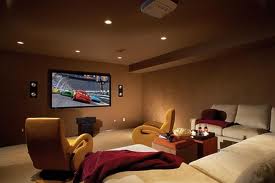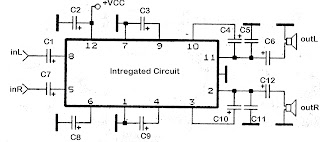Normal
headphones have an impedance of 32R per channel. The usual standard line
output of 775 mV to which all quality equipment aspires will generate a
power of U2 / R = 0.7752 / 32 = 18 mW per channel across a headphone
of this impedance. An examination of available headphones at well known
high street emporiums revealed that the sensitivity varied from 96 dB
to 103db/mW! So, in practice the circuit will only require unity gain
to reach deafening levels. As a unity gain design is required it is
quite possible to employ a low distortion output stage.
The
obvious choice is an emitter follower. This has nearly unity gain
combined with a large amount of local feedback. Unfortunately the
output impedance of an emitter follower is dependent upon the source
impedance. With a volume control, or even with different signal sources
this will vary and could produce small but audible changes in sound
quality. To prevent this, the output stage is driven by a cathode
follower,based around an ECC82 valve (US equivalent: 12AU7).
This
device, as opposed to a transistor configuration, enables the output
stage to be driven with a constant value, low impedance. In other
words, the signal from the low impedance point is used to drive the
high impedance of the output stage, a situation which promotes low
overall THD. At the modest output powers required of the circuit, the
only sensible choice is a Class A circuit. In this case the much
vaunted single-ended output stage is employed and that comprises of T3
and constant current source T1-T2.
The
constant current is set by the Vbe voltage of T1 applied across R5
With its value of 22R, the current is set at 27 mA. T3 is used in the
emitter follower mode with high input impedance and low output
impedance. Indeed the main problem of using a valve at low voltages is
that it’s fairly difficult to get any real current drain. In order to
prevent distortion the output stage shouldn’t be allowed to load the
valve. This is down to the choice of output device. A BC517 is used for
T3 because of its high current gain, 30,000 at 2 mA! Since we have a
low impedance output stage, the load may be capacitively coupled via
C4.
Some purists may baulk at the idea of using an electrolytic
for this job but he fact remains that distortion generated by
capacitive coupling is at least two orders of magnitude lower than
transformer coupling. The rest of the circuitry is used to condition
the various voltages used by the circuit. In order to obtain a linear
output the valve grid needs to be biased at half the supply voltage.
This is the function of the voltage divider R4 and R2. Input signals
are coupled into the circuit via C1 and R1.
R1, connected
between the voltage divider and V1’s grid defines the input impedance
of the circuit. C1 has sufficiently large a value to ensure response
down to 2 Hz. Although the circuit does a good job of rejecting line
noise on its own due to the high impedance of V1’s anode and T3’s
collector current, it needs a little help to obtain a silent background
in the absence of signal. The ‘help’ is in the form of the capacitance
multiplier circuit built around T5. Another BC517 is used here to
avoid loading of the filter comprising R7 and C5. In principle the
capacitance of C5 is multiplied by the gain of T5.
In practice
the smooth dc applied to T5’s base appears at low impedance at its
emitter. An important added advantage is that the supply voltage is
applied slowly on powering up. This is of course due to the time taken
to fully charge C5 via R7. No trace of hum or ripple can be seen here on
the ‘scope. C2 is used to ensure stability at RF. The DC supply is
also used to run the valve heater. The ECC82 has an advantage here in
that its heater can be connected for operate from 12.6 V.
To run
it T4 is used as a series pass element. Base voltage is obtained from
the emitter of T5. T4 has very low output impedance, about 160 mR and
this helps to prevent extraneous signals being picked up from the
heater wiring. Connecting the transistor base to C5 also lets the valve
heater warm up gently. A couple of volts only are lost across T4 and
although the device runs warm it doesn’t require a heat-sink.



















 However, before you may need to think of the basic home theater design for your home theater system, you may need to know the size of the room for the home theater set up. The size of the room to where the home theater will be set up will depend on how basic the home theater design needs to be.
However, before you may need to think of the basic home theater design for your home theater system, you may need to know the size of the room for the home theater set up. The size of the room to where the home theater will be set up will depend on how basic the home theater design needs to be.










 Simple Stabilizer Circuit Diagram
Simple Stabilizer Circuit Diagram



 Commercially available hearing aids are expensive. Here is a cheap hearing aid circuit that uses only four transistors and some passive components. In moving the power switch S to on position, the condenser microphone detects the sound signal, which is amplified by transistor T1 and T2.
Commercially available hearing aids are expensive. Here is a cheap hearing aid circuit that uses only four transistors and some passive components. In moving the power switch S to on position, the condenser microphone detects the sound signal, which is amplified by transistor T1 and T2.






